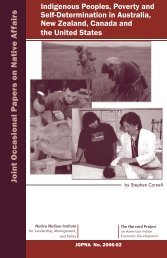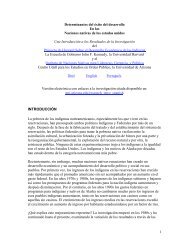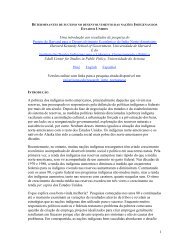American Indian Self-Determination - Native Nations Institute ...
American Indian Self-Determination - Native Nations Institute ...
American Indian Self-Determination - Native Nations Institute ...
- No tags were found...
You also want an ePaper? Increase the reach of your titles
YUMPU automatically turns print PDFs into web optimized ePapers that Google loves.
<strong>American</strong> <strong>Indian</strong> <strong>Self</strong>-<strong>Determination</strong>Stephen CornellJoseph P. KaltEconomic Development on <strong>American</strong> <strong>Indian</strong> Reservations,” in Cornell and Kalt, ed., WhatCan Tribes Do? Strategies and Institutions in <strong>American</strong> <strong>Indian</strong> Economic Development (LosAngeles: University of California, <strong>American</strong> <strong>Indian</strong> Studies Center, 1992); and Sovereigntyand Nation-Building: The Development Challenge in <strong>Indian</strong> Country Today” (with StephenCornell), The <strong>American</strong> <strong>Indian</strong> Culture and Research Journal, vol. 22, no. 3, February 1999.24M.B. Krepps and R.E. Caves, “Bureaucrats and <strong>Indian</strong>s: Principal-Agent Relations andEfficient Management of Tribal Forest Resources,” Journal of Economic Behavior and Organization24, no. 2 (July 1994) at 133-151.25SONN at 124-25.26SONN at 151-52.27SONN at 155; S. Cornell and J. Kalt, “Two Approaches to the Development of <strong>Native</strong> <strong>Nations</strong>:One Works, the Other Doesn’t,” in Miriam R. Jorgensen, ed., Rebuilding <strong>Native</strong> <strong>Nations</strong>:Strategies for Governance and Development (Tucson: Univ. of Arizona Press, 2007)at 3-4.28See, for example, Edwards, Chris, “Downsizing the Federal Government” in Policy Analysis(Washington, D.C.: Cato <strong>Institute</strong>, June 2, 2004.29National <strong>Indian</strong> Health Board, Tribal Perspectives on <strong>Indian</strong> <strong>Self</strong>-<strong>Determination</strong> and <strong>Self</strong>-Governance in Health Care Management, 1998.30S. Wakeling, M. Jorgensen, S. Michaelson, and M. Begay, Policing on <strong>American</strong> <strong>Indian</strong>Reservations: A Report to the National <strong>Institute</strong> of Justice (Cambridge, MA: Harvard Projecton <strong>American</strong> <strong>Indian</strong> Economic Development, 2000).31Doble, John and Yarrow, Andrew, Walking a Mile: A First Step Toward Mutual <strong>Self</strong>-Interest— Exploring How <strong>Indian</strong>s and Non-<strong>Indian</strong>s Think About Each Other (New York: PublicAgenda, 2007), at http://www.publicagenda.org/reports/walking-mile-first-step-towardmutual-understandingaccessed May 18, 2010.32SONN at Chapter 1.33See, for example, Statement of President Ronald Reagan on <strong>American</strong> <strong>Indian</strong> Policy,January 24, 1983.34Cornell and Kalt, What Can Tribes Do?..., op. cit. at 35-36.35Rebuilding <strong>Native</strong> <strong>Nations</strong>…, op. cit at 61-62.36Lyndon B. Johnson, “The President’s Message to the Congress on Goals and Programsfor the <strong>American</strong> <strong>Indian</strong>,” United States Congress, Washington DC, March 6, 1968.37Richard M. Nixon, “Special Message On <strong>Indian</strong> Affairs,” United States Congress, Washington,DC, July 8, 1970 (“Special Message on <strong>Indian</strong> Affairs”).38Ibid.31







